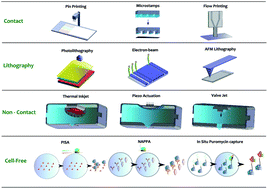A critical comparison of protein microarray fabrication technologies
Abstract
Of the diverse analytical tools used in proteomics, protein microarrays possess the greatest potential for providing fundamental information on protein, ligand, analyte, receptor, and antibody affinity-based interactions, binding partners and high-throughput analysis. Microarrays have been used to develop tools for drug screening, disease diagnosis, biochemical pathway mapping, protein–protein interaction analysis, vaccine development, enzyme–substrate profiling, and immuno-profiling. While the promise of the technology is intriguing, it is yet to be realized. Many challenges remain to be addressed to allow these methods to meet technical and research expectations, provide reliable assay answers, and to reliably diversify their capabilities. Critical issues include: (1) inconsistent printed microspot morphologies and uniformities, (2) low signal-to-noise ratios due to factors such as complex surface capture protocols, contamination, and static or no-flow mass transport conditions, (3) inconsistent quantification of captured signal due to spot uniformity issues, (4) non-optimal protocol conditions such as pH, temperature, drying that promote variability in assay kinetics, and lastly (5) poor protein (e.g., antibody) printing, storage, or shelf-life compatibility with common microarray assay fabrication methods, directly related to microarray protocols. Conventional printing approaches, including contact (e.g., quill and solid pin), non-contact (e.g., piezo and inkjet), microfluidics-based, microstamping, lithography, and cell-free protein expression microarrays, have all been used with varying degrees of success with figures of merit often defined arbitrarily without comparisons to standards, or analytical or fiduciary controls. Many microarray performance reports use bench top analyte preparations lacking real-world relevance, akin to “fishing in a barrel”, for proof of concept and determinations of figures of merit. This review critiques current protein-based microarray preparation techniques commonly used for analytical and function-based proteomics and their effects on array-based assay performance.


 Please wait while we load your content...
Please wait while we load your content...